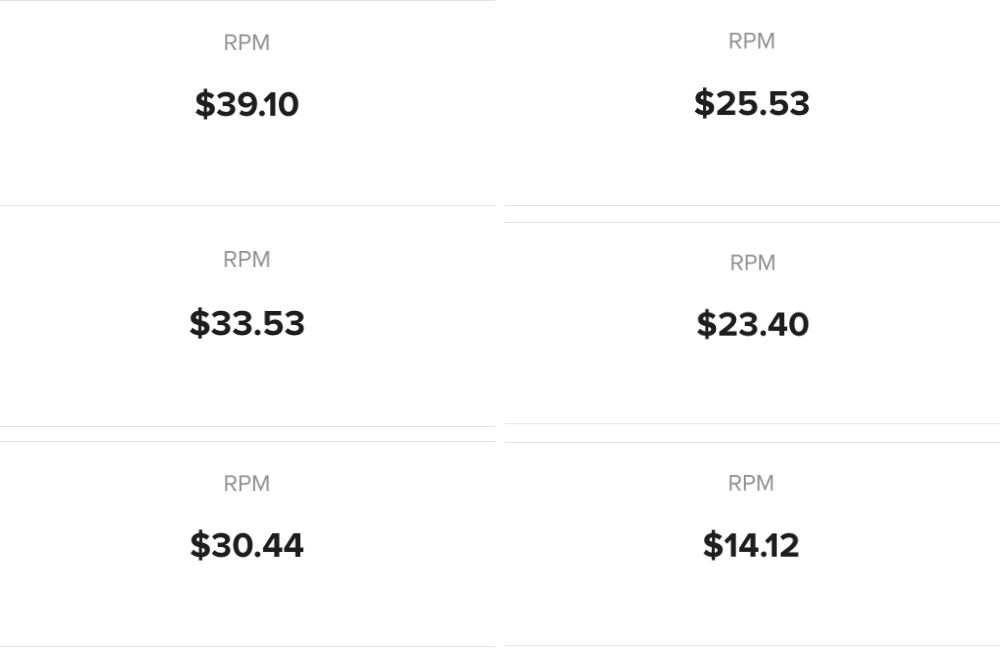If it weren’t for advertising there would be far less free content. Fewer TV shoes. Fewer radio stations. Fewer websites.
For years, advertising drove content. It still does despite Netflix and other streaming services disrupting the traditional model.
Nevertheless, TV and radio ad revenue are still strong. Website ad revenue is as robust as ever.
The question is, how does website ad revenue stack up against TV and radio ads?
I was curious so I starting reading about it which then developed into this brief post.
Here it goes.
Starting point: Ad rates on a CPM basis
TV ad rates (CPM)
Just like website ads, TV ads often charge on a CPM basis, which is cost per 1,000 viewers. Here are some sample CPM rates for a 60-second ad spot in various US cities:
Source: Fitsmallbusiness.com
The above rates can vary depending on many factors such as time-of-day the ad airs. But it gives us a ballpark figure.
Because TV ads typically air in 2-minute batches, the CPM for the station owner is double the above rates for that specific ad segment.
Radio ad rates (CPM)
Radio ad rates are also priced on a CPM basis. The general CPM range is $12 to $16 per 30-second ad.
Website ad rates (CPM)
The range is huge, but a well-monetized website in a half-decent niche with US traffic should earn $5 to $15 CPM (cost per 1,000 page views). Let’s call it $8 CPM.
We’re not done yet. There’s a better metric to use when comparing ad revenue across these ad channels. It’s ad revenue per viewer/listener/visitor. Let’s call it ad revenue per consumer (as in content consumer).
Ad revenue per consumer
While I think it’s clear website ads earn less than TV and radio ads, the difference is much bigger.
CPM, while a good measurement when quoting rates to advertisers, it doesn’t provide an accurate picture when comparing revenue to the publication (i.e. TV station, radio station or website publisher).
A better metric to compare ad rates across these advertising channels is revenue per 1,000 viewers/listeners/visitors. In other words, revenue per 1,000 pairs of eyeballs/ears.
When we do this, you’ll see TV and radio advertising far surpass website ads. Here’s an example. Please note I make a lot of assumptions.
TV ad revenue per 1,000 viewers
These days, there are 14 minutes of ads per 60 minutes of TV programming. This means there are fourteen 60-second ads per hour. That means a Los Angeles TV station earns 1,000/1,000 x $34.75 x 14 = $486.50 per hour per 1,000 viewers.
If 50,000 people watch for 60 minutes, total revenue is 60 x $486.50 = $24,325.
Radio ad revenue per 1,000 listeners
Radio stations run about twenty 30-second commercials per hour. With a $14 CPM, that amounts to the following revenue per hour per 1,000 listeners:
1,000/1,000 x $14 x 20 = $280.
If 50,000 people are listening, hourly ad revenue is 50 x $280 = $14,000.
Website ad revenue per 1,000 visitors
The trouble with estimating revenue per 1,000 website visitors is that the range in the number of page views per visitor across websites is huge. However, most sites probably average 1.5 to 5 page views per visitor. For this analysis, let’s use an average of 2.5 page views per visitor.
Based on that assumption, ad revenue per 1,000 visitors is 1,000/1,000 x $8 x 2.5 = $20.
Clearly, ad revenue per consumer for websites is dramatically lower than TV and radio.
Unfortunately, this is the part where the comparison breaks down because consumers consume TV and radio in much bigger chunks at a time. In fact, that is one reason TV and radio is far more lucrative than website advertising. Website visitors come and go within minutes (or less) while people routinely watch 30 to 60+ minutes of TV at a time and routinely listen to 15 to 60+ minutes of radio at a time.
It’s not all gloom and doom for websites
While the above make TV and radio advertising look like the big winners, they aren’t necessarily. Yes, revenue can be impressive, but the costs involved are infinitely higher than running websites.
You can bootstrap a website with $5 per month hosting and build from there.
You can’t bootstrap a TV station, network or cable channel on $5 per month. Same with radio.
Just to get rolling in TV or radio costs a fortune. Not so with websites.
And yet, you can build up a website to earn tens of thousands, hundreds of thousands or even millions per month. While your website expenses will grow considerably at those levels, you have more control over them on a month to month basis.
Why did I do this?
My friend and I were spitballing on Skype and he thought it would be interesting to see how TV ad rates compared to website advertising revenue. I thought it an interesting question too. I threw in radio just for fun since I was doing the research anyway.

Jon Dykstra is a six figure niche site creator with 10+ years of experience. His willingness to openly share his wins and losses in the email newsletter he publishes has made him a go-to source of guidance and motivation for many. His popular “Niche site profits” course has helped thousands follow his footsteps in creating simple niche sites that earn big.







